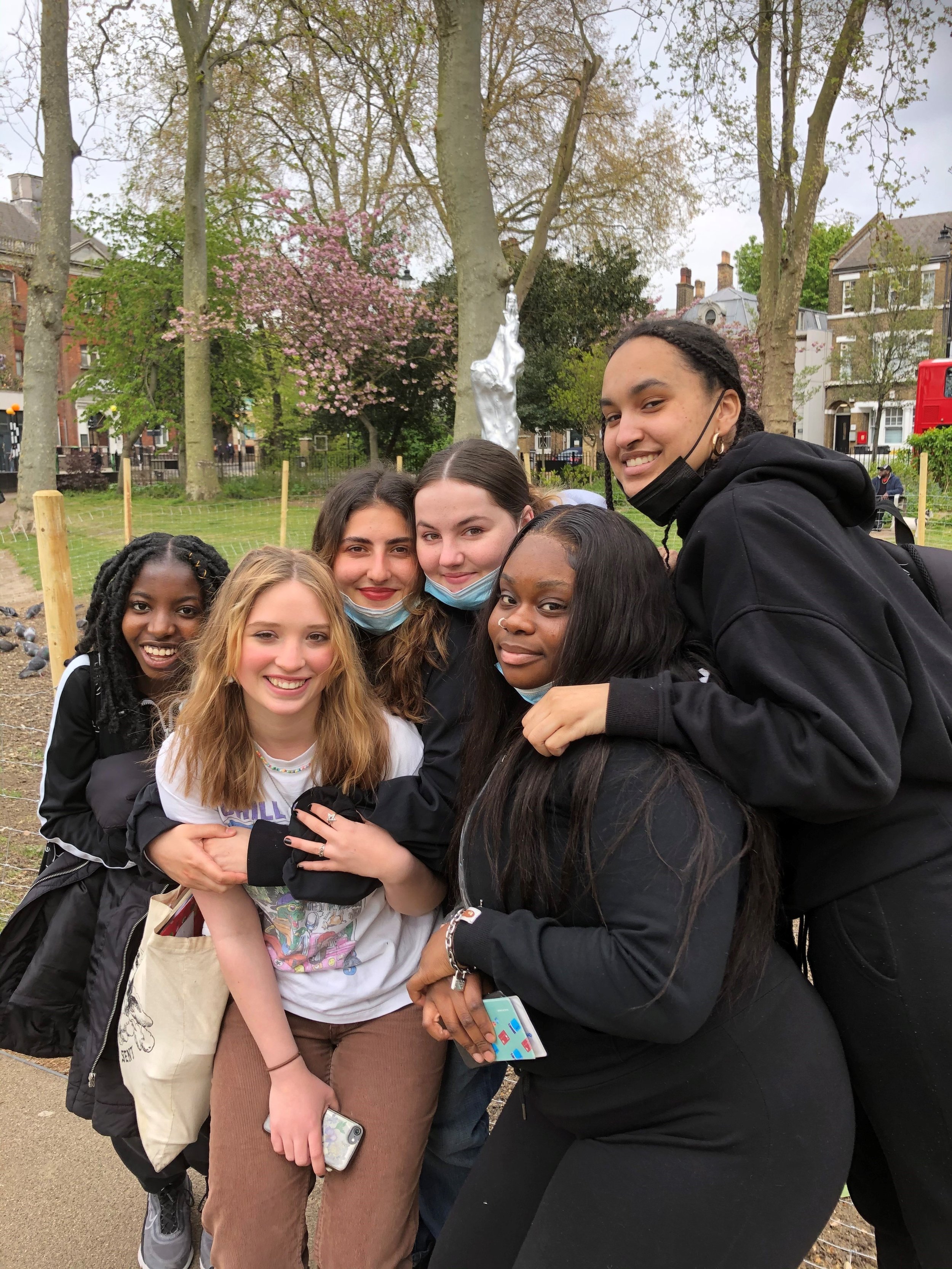Bee Rowlatt on the life of a Spitalfields-born hero whose life continues to inspire
Credit: STEWY
Somewhere beneath the shiny corporate blocks of Liverpool Street is the birthplace of the foremother of feminism. Mary Wollstonecraft was also the punk of the British Enlightenment, a fearless advocate of human rights and a daredevil in her personal life. She was born in Spitalfields, in a house on Primrose Street that has long since been demolished, the second of seven kids in a downwardly-mobile family. Grandpa Wollstonecraft was a well-to-do handkerchief maker, but his wealth was gradually squandered. His son, Mary Wollstonecraft’s father, moved his family first to Epping Forest and then Barking in a doomed attempt at being a gentleman farmer.
Onwards to Yorkshire, and Wales, and “each farm he took was poorer and remoter than the last.”[1] Being forced to sit in silence for hours on end, and trying to defend her mother from the alcohol-fuelled violence of her father - these were the cornerstones of Wollstonecraft’s young life, and they sparked her lifelong rage against injustice.
Despite becoming a writer of international renown, Wollstonecraft remained economically precarious for the rest of her life. And although her family didn’t believe in educating girls, they didn’t seem to mind living off her earnings once she managed to educate herself. Pre-Enlightenment people generally kept to their place in the ancient scheme of things, but Wollstonecraft was at the heart of this revolutionary era: everything was up for grabs. She made her way back to London and began her writing career, exploring the still-emerging idea of universal human rights.
This is explicit in her pioneering work A Vindication of the Rights of Men (1790). Here’s where Wollstonecraft’s ideas around justice germinate, and the key to them is reason. Reason is the human capacity for rational thought – this is the basis of her relentless attacks on the establishment, from royalty to slavery. Our ‘god-given Reason’ sets humanity above the ‘brute creation’ and gives us the means to challenge the existing order. How do we do this? By being educated. Her most famous work, A Vindication of the Rights of Woman (1792), demands education for all. It was the earliest call for gender equality in the English language.
Wollstonecraft’s personal life was equally radical, transgressing the norms of the day with the women she loved, her hostility to marriage and her extra-marital pregnancies. This fluidity is present in her genre-defying writing. Novelist Kamila Shamsie describes Wollstonecraft’s Wrongs of Women as “a revolutionary work – most strikingly for the friendship she creates between two women from vastly different class backgrounds who discover common ground in the injustices they face as women.”[2]
Hailed by Virginia Woolf for her ‘experiments in living’, Wollstonecraft died not one, but two deaths. First in childbirth, bringing the author Mary Shelley into the world – the agonising post-partum infection took 10 days to finish her off. Wollstonecraft’s was “an interrupted life.”[3] She was only 38, and she left behind two daughters and a devastated husband, the anarchist philosopher William Godwin.
Godwin, still grieving, wrote her first biography, unwittingly bringing about Wollstonecraft’s second death: her reputation was killed in the scandal following his revelation of her unconventional life and loves. The floodgates opened. Trolling poems were circulated, including an exceptionally unpleasant work called The Un-sex’d Females, crowing that Wollstonecraft was a “poor maniac” a “voluptuous” victim of “licentious love.” These misogynistic attacks were sustained in the public domain for years.
Wollstonecraft has long been an inspiration to me, in particular the 1795 voyage in search of her lover’s missing shipment of silver, smuggled out of revolutionary Paris and last seen off the rocky shores of the Skagerrak sea. She travelled with her baby, and I retraced their doomed treasure-hunt with my own baby in tow, for my book In Search of Mary. But over the years I have given countless talks and lectures about her, regularly coming up against: Mary who? Most people had no idea who she was, let alone how to spell her name.
It shows how easily our great women are lost – or erased – from history, and how vital it is to widen the scope of our historical awareness. It’s why the work of the East End Women’s Museum matters so much. It’s also why I campaigned for a memorial to Wollstonecraft. Which, after ten years of fund-raising, took a turn for the very strange…
Maggi Hambling’s memorial Sculpture for Wollstonecraft elevates an idea, rather than the traditional hero on a pedestal. Our small team of volunteers worked for a decade towards its unveiling in 2020, almost overnight it became the most hated memorial in living memory. Much like the trolling that followed Wollstonecraft’s death, the ‘rude bits’, in this case – the nakedness – were the primary cause of rage.
The female figure is defiant and challenging, emerging at the top of a seven-foot silvered bronze, with abstract female forms supporting and lifting her up. Artist Maggi Hambling’s explicit intention, using the lost wax process, was to ‘capture the spirit of Mary Wollstonecraft and the fight for the rights of women. It’s a struggle that goes on – and so the figure is a challenge to our world.’
It’s fair enough for people not to like the sculpture, but the heat and the speed of judgement were not so fair, nor the way it was misrepresented. Instead of seeing the complete work, what people saw online was a tightly-cropped version showing only the breasts and pubic hair. In contrast if you see the whole work in real life, these are the last features you see. But it was the limited view that went viral, stoking the ‘nudie’ outrage.
Overwhelmingly the critics wanted a conventional statue in the Victorian tradition: a representational figure on a pedestal. Maybe they didn’t know how much the Victorians hated Wollstonecraft. She herself defied traditions; ‘I am the first of a new genus!’ she once wrote in a letter to her sister. Why should a radical trouble-maker be memorialised just like everyone else? But the attackers were furious: ‘monstrous’; ‘disgusting’ they called it, and ‘a betrayal’.
Biographer Claire Tomalin shows how the scandal around Wollstonecraft’s private life gave way after her death to a ‘steady campaign of denigration from women writers.’ The same could be said of the sculpture’s reception. Perhaps this was a side-effect of lockdown, but it also highlights the dearth of representation of women in public art. When I put a callout on Newsnight for detractors to focus instead on supporting campaigns for other women, a flood of funding followed. Perhaps when there are more memorials of women, the existing few won’t have to work quite so hard?
Even so, Maggi’s work has been attacked in the past, and she joins a long tradition. A notable example is the Shaftesbury Memorial Fountain on Piccadilly Circus. Mistakenly known as Eros, the silvery figure representing selfless love was unveiled in 1893 to memorialise Lord Shaftesbury’s philanthropic legacy. Now beloved, back then it was so loathed it had to be guarded for a year.
Raising a long-overdue memorial to Mary Wollstonecraft was a weird journey, but the most important outcome was the unprecedented world-wide surge of interest in “one of the most underestimated thinkers of the 18th century”[4]. A conventional statue could not have achieved this. As my mum remarked: well you wanted people to know who she was…
Since then the Wollstonecraft Society (WS), a human rights education charity, has been busy helping school children discover Wollstonecraft’s astonishing life and huge legacy. WS collaborates with other excellent charities such as Lifting Limits to tackle the gender inequalities children meet as they grow up. WS has funded an arts prize for children inspired by her writing; distributed the first comic book based on her life, and taken learning materials into schools around the country. The talented students at Northmoor Academy in Oldham even created a musical tribute to her.
Sixth form drama students at La Sainte Union school in London also created a performance inspired by her life, and the group paid tribute by visiting the memorial sculpture. Kezia Adewale said the trip was part of her A-level coursework, adding “It’s so important to remember great women and their achievements because they paved the way! It matters for all of us, for everyday people and even for people like Malala.”
Mary Wollstonecraft’s story is a rollercoaster ride, but the most exciting part is her ongoing influence. We all need to deepen our understanding of our own histories, and there is growing hunger for the lesser-known stories of people whose lives made a difference to our world. In Kezia’s words: “Mary Wollstonecraft is someone you can learn about and when you think about her life it makes you feel better. I get inspiration and think - I want to be like that in the future. They are proof of what you can do.”
Bee Rowlatt’s book In Search of Mary is inspired by Wollstonecraft’s pioneering travels. Bee led the memorial campaign Mary on the Green and is chair of the Wollstonecraft Society. She also wrote the introduction to a new edition of Wollstonecraft’s Vindications (2022, Renard Press)
[1] Janet Todd, Mary Wollstonecraft: A Revolutionary Life (London: Weidenfeld & Nicolson, 2000), p.164
[2] Kamila Shamsie in theatre programme for An Amazon Stept Out by Bee Rowlatt, directed by Honor Borwick, Lyric Theatre, London, 30th September 2019 (London: Wollstonecraft Society, 2019)
[3] Lyndall Gordon, Vindication: A Life of Mary Wollstonecraft (London: Little, Brown, 2005) p.390
[4] Amartya Sen, The Idea of Justice (London: Allen Lane, 2009)






